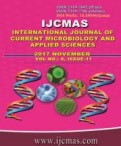


 National Academy of Agricultural Sciences (NAAS)
National Academy of Agricultural Sciences (NAAS)

|
PRINT ISSN : 2319-7692
Online ISSN : 2319-7706 Issues : 12 per year Publisher : Excellent Publishers Email : editorijcmas@gmail.com / submit@ijcmas.com Editor-in-chief: Dr.M.Prakash Index Copernicus ICV 2018: 95.39 NAAS RATING 2020: 5.38 |
Nanotechnology is mainly concerned with synthesis of nanoparticles of variable sizes, shapes, chemical compositions and controlled dispersity with their potential use for human benefits. The subject nanotechnology deals with manufacturing, study and manipulation of matter at nano scale in the size range of 1-100 nm which may be called as nanoparticles. Development of green nanotechnology is creating interest of researchers towards eco-friendly biosynthesis of nanoparticles. Biomolecules present in plant extracts can be used to reduce metal ions into nanoparticles in a single-step green synthesis process. Tulasi (Ocimum sanctum L.) is an aromatic plant belongs to family Lamiaceae. Tulasi is a traditional medicinal plant of India, having good source of bio-reduction and stabilizers. The constituent of tulasi are alkaloids, glycosides, tannins, saponins and aromatic compounds and also it contains minerals like Ca, Mn, Cu, Zn, P, K, Na, and Mg where the concentration of Cu is more in tulasi leaves than other leaves. It constitutes 12.31 mg/kg of Cu. Recently Ocimum sanctum L. leaf extracts have been used in the synthesis of silver nanoparticles and gold nanoparticles. Tulasi is a source of bio-reduction and stabilizers. The copper is highly toxic to microorganisms such as bacteria. copper nanoparticles were synthesized from various plant extracts such as Hibicus rosasinensi, Ocimum santanum leaf extract, Syzygium aromaticum (Cloves), Lemon fruit extract, Vitis vinifira extract, Eucalyptus, Cassia alata, Centellaasiatica, Malva sylvestris etc. Various instrumental techniques were adopted to characterize the synthesized Cu NPs, viz., Dynamic light scattering analyzer (Zetasizer), UV–Vis spectroscopy, FTIR, SEM, TEM and XRD.
 |
 |
 |
 |
 |